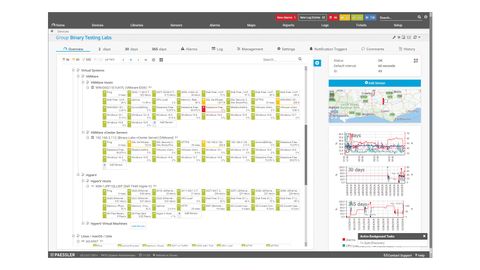IT Pro Verdict
Pros
- +
Swift setup
- +
Heaps of sensor options
- +
Reasonable cloud monitoring options
- +
Great notification options
Cons
- -
Automatic discovery can eat up sensors quickly
If you’re keen to keep costs under control then Paessler’s PRTG Network Monitor is well worth a look, as it’s priced solely by sensor count. It’s versatile too: a single sensor can track any of 276 different metrics across your network, enabling the software to keep an eye on servers, desktops, storage devices, cloud services, applications, databases and more. New sensors are continually under development, with this latest edition bringing monitors for SQL Server 2019 databases, cloud web server loads and Dell EMC Unity storage arrays.
Despite the sophistication of the software, setup is very simple. We launched the installer on a Windows Server 2019 host and were greeted by a smart setup wizard, which gets the discovery process up and running. Once this is done, basic monitoring is set up for you, with appropriate sensors automatically assigned to each discovered device. The only catch is that this can quickly eat up your allowance: our 52-port Gigabit switch accounted for 73 sensors on its own, while a VMware vCenter Server took 34 and even a Qnap eight-bay rack NAS appliance managed to stack up a further 27. You can decommission any sensors you don’t need and redeploy them to more useful places, but this could be a tiresome process on larger networks.
Once everything’s up and running, you can check in on your network health via the PRTG web console, use the Windows or Mac desktop apps, or open up the free iOS and Android mobile apps. The homepage presents a complete overview of your entire network and its active status links let you jump straight to alerts, warnings or issues with one click.
Switch to the device view and you’ll see all your monitored devices sorted into hierarchical groupings, from which they inherit settings such as discovery schedules and login credentials. PRTG colour-codes each one, meaning you can instantly spot devices that are down, paused or in a warning state, and hovering the mouse pointer over a device pops up a window showing live graphs and any active alert messages.

Alongside the usual workstations and bits of infrastructure, PRTG can monitor virtual hosts, with a selection of sensors on offer for VMware, Hyper-V and Citrix XenServer. It’s good to see iDRAC and iLO sensors too, which kept us posted on the health of our Dell and HPE servers, while dedicated Qnap and Synology sensors can reveal the general health of a NAS appliance, pool and volume capacities, and even the temperature of each hard disk.
The package also comes with a fair set of cloud-monitoring features, including eight different Amazon CloudWatch sensors, plus others for Microsoft 365, Dropbox, OneDrive and Google Drive. You’ll have to pay extra for Microsoft Azure, though: AutoMonX offers an add-on pack for PRTG that can discover and monitor 20 resource types, but prices for a perpetual licence start at around £1,175.
Notification methods are plentiful, with options to send alerts via SMS, Syslog, Slack, Microsoft Teams and Amazon SNS, as well as old-school email. Mobiles running the PRTG apps can show push notifications too, and events can be linked to actions such as running a program or stopping and restarting services.
With plenty of ways to check up on your network status, and so many sensor types included in the price, PRTG Network Monitor 20.3 is a great choice for businesses that want to keep an eye on all of their network devices and services – while also keeping an eye on their expenditure.
Dave is an IT consultant and freelance journalist specialising in hands-on reviews of computer networking products covering all market sectors from small businesses to enterprises. Founder of Binary Testing Ltd – the UK’s premier independent network testing laboratory - Dave has over 45 years of experience in the IT industry.
Dave has produced many thousands of in-depth business networking product reviews from his lab which have been reproduced globally. Writing for ITPro and its sister title, PC Pro, he covers all areas of business IT infrastructure, including servers, storage, network security, data protection, cloud, infrastructure and services.



